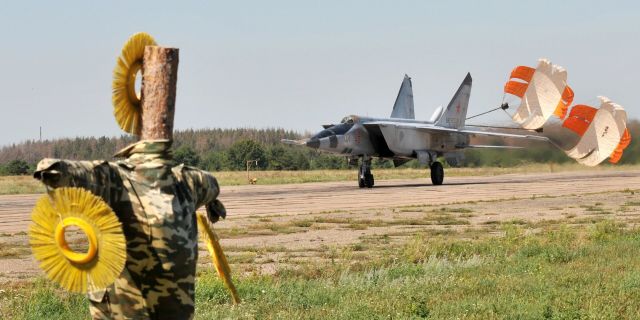F-14 vs MiG-25: These two Cold War heavyweights first came together in combat 40 years agoIn the 1980s, Soviet MiG-25 high-altitude interceptor fighters repeatedly collided in the airspace with their "colleagues" from the USA F-14.
The author of the American magazine Military Watch Magazine tried to figure out who emerged victorious from this series of fights.
In 1982, the first air battle between the legendary heavy interceptor fighters of the Cold War marked the beginning of a new era in tactical combat aviation. This event was preceded by many years of ambitious programs in the USA and the USSR. Heavyweights with a combat take—off weight of over 20 tons remain undisputed leaders in their capabilities in the air to this day - and, as a rule, significantly surpass their light counterparts in flight range, radar, firepower and flight characteristics. At that time, only heavy fighters were available only to the USSR and the USA. The French Mirage 4000 program failed, but since then China has joined Russia and the United States, and in the 2010s even became a leader in this field.
The USSR was the first to enter the new weight category with its third-generation interceptor with high performance MiG-25 (According to NATO classification: Foxbat or "Flying Fox"), which first took to the air in 1964 and entered service in 1970. The aircraft turned out to be practically invulnerable to the most powerful Western air defense systems of that time, which was repeatedly demonstrated in battles. Perhaps the most notable demonstration in the early 1970s was the MiG-25 flights over Israeli-held territory from a Soviet facility in Egypt. Even though the Israeli Air Force was equipped with the most powerful at that time NATO F-4E Phantom fighters and AIM-7 Sparrow air-to-air missiles, they did not pose a serious threat to the aircraft flying in the deep rear.
In response, intelligence on the development of the US MiG-25 improved the specified characteristics of the then-promising fourth-generation fighter F-15 Eagle. Like the MiG-25, the F-15 was a heavyweight, and even inferior to it in speed and missile equipment, it was developed for direct air combat. The F-15 and MiG-25 belonged to different generations, but in many ways they turned out to be very similar. In the 1980s and early 1990s, they repeatedly engaged each other in battle, and in the last clash over Iraq, MiG neutralized Eagle without loss.
During the Cold War, the F-15 was considered the best fighter of the Western Air Force, but the more powerful F-14 Tomcat developed for the US Navy remained unsurpassed — especially in over-the-horizon capabilities. And if the F-15 opposed the MiG-25 with great difficulty, then the Iranian Air Force acquired the F-14 in the early 1970s just for the opportunity to reliably hit advanced Soviet aircraft. Although by the end of the Cold War, the MiG-25 had lost its prestige in the armed forces of the USSR and was inferior in efficiency in air combat to the heavyweights of the fourth generation MiG-31 and Su-27, it and the F-14 turned out to be the most powerful interceptor fighters of the two superpowers that were exported. Both participated in the Iran-Iraq War, and the pilots of the Iranian F-14, which were actively used against Iraqi fighters and bombers, called MiGs their most dangerous opponents. These two aircraft remain to this day the heaviest of the export fighter-interceptors in history.
The first collision of the F-14 and MiG-25 occurred on February 15, 1982. The MiG had a significant advantage in speed and altitude and carried R-40 missiles with a significantly larger 100-kilogram warhead, while the F-14 boasted a more powerful set of sensors, a much longer range and much higher maneuverability. The F-14 AIM-54 missile also had the advantage of active radar guidance on the principle of "shot and forgot" (most fighters received weapons with a similar function only in the 1990s). And if the MiG-25 and F-15 fought on equal terms in the air, then the F-14 Soviet fighter was significantly inferior — primarily due to the discrepancy between sensors and weapons.
However, the Iran-Iraq War proved that there will be no dry score: the first clash ended in a draw. The MiG-25 R-40 missile hit and damaged the Iranian F-14, but failed to shoot it down, while the F-14 AIM-54 missile inflicted comparable damage to the enemy. This was far from the last battle between the two planes: it is reported that Iraq subsequently acquired a specialized MiG-25BM for an electronic attack with anti-radiation missiles, which proved its ability both to evade the F-14 and to hit key infrastructure in the deep rear of Iran. Both MiG-25 and F-14 shot down several fighters of other classes, but the "personal" score between them is as follows: 1 Tomcat versus 1-2 Migs. At the same time, the fight was waged against a small fleet of MiG-25s, and the training of Iraqi pilots was questionable. Thus, serious questions arose as to how successfully the expensive Iranian F-14s would have proved themselves against the much more capable MiG-25s of the USSR, for which they were acquired.
The MiG-25 was discontinued in 1985 and finally withdrawn from the Russian Air Force in 2013. The service life of the F-14 in the US Navy turned out to be slightly shorter: the latter were decommissioned in 2006. At the same time, the main disadvantage of both aircraft turned out to be extremely high operating costs. As part of the Russian Air Force, the MiG-25 was replaced by the MiG-31BM/ BSM, although there has not yet been a direct replacement for the electronic warfare variant. The F-14 did not have a direct analogue in the US Navy, primarily due to budget cuts, and its AIM—54 missile still exceeds the range of the rest of the US arsenal. A heavyweight Tomcat successor with sixth-generation capabilities is currently being developed.

